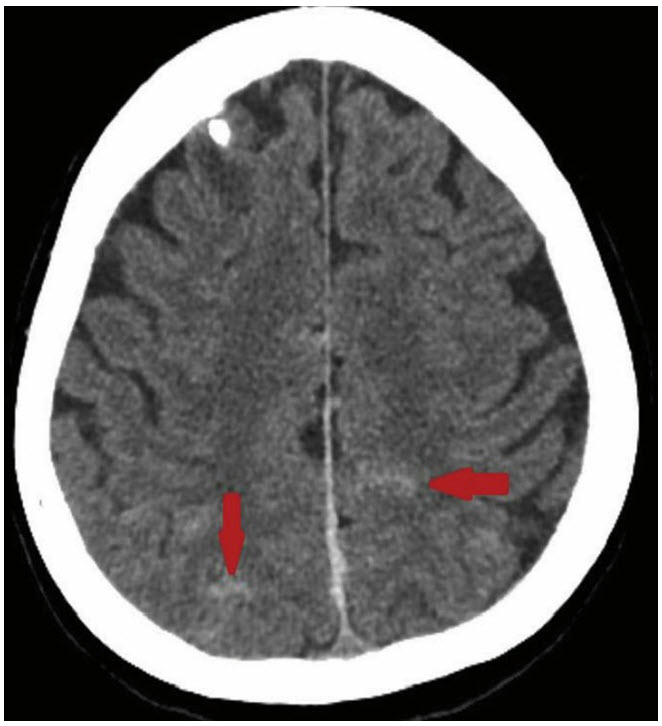Question 9#
A 52-year-old female is admitted to the neuro ICU after a fall down five stairs. She did not lose consciousness but was confused for several hours after the fall. She is not intubated. A CT head was obtained and demonstrated SAH overlaying the cerebral cortex.

Axial noncontrast head CT. The arrows point out areas of subarachnoid hemorrhage present in the deep sulci of the bilateral frontal lobes.
Which of the following is true about this patient?
A. She is at high risk for vasospasm in the 4 to 14 days postbleed periodB. A catheter angiogram is to be obtained within the first 48 hours to rule out vascular malformations and repeated in 1 week if the first one was negative
C. She does not need to be worked up for polycystic kidney disease
D. She is at high risk of ischemic stroke in the left middle cerebral artery (MCA) territory
E. She is likely to have a coagulopathy
Correct Answer is C
Comment:
Correct Answer: C
Trauma to the head can be associated with small foci of cortical SAH. Usually these are caused by the rupture of small superficial cortical vessels. Polycystic kidney disease can be associated with berry aneurysms causing aneurysmal subarachnoid bleeds, but not with traumatic hemorrhages. Unlike aneurysmal SAH, the risk of clinically significant vasospasm is low in these superficial traumatic SAHs. While a CT angiogram is a good way to rule out underlying vascular lesions, a catheter angiogram is not usually indicated to investigate traumatic SAH unless there is a high suspicion for vasospasm or an underlying vascular abnormality. Patients with normal coagulation profiles can still have small traumatic subarachnoid bleeds following head trauma, and this in itself is not concerning for a clotting disorder. Mild trauma of this nature is not a risk factor for large territorial strokes.
References:
- Pirson Y, Chauveau D, Torres V. Management of cerebral aneurysms in autosomal dominant polycystic kidney disease. J Am Soc Nephrol. 2002;13(1):269-276.
- Paiva WS, Muniz R, Paganelli P, et al. The prognosis of the traumatic subarachnoid hemorrhage: a prospective report of 121 patients. Int Surg. 2010;95(2):172-176.
- Izzy S, Muehlschlegel S. Cerebral vasospasm after aneurysmal subarachnoid hemorrhage and traumatic brain injury. Curr Treat Options Neurol. 2014;16(1):278.
- Witiw CD, Byrne JP, Nassiri F, et al. Isolated traumatic subarachnoid hemorrhage: an evaluation of critical care unit admission practices and outcomes from a North American perspective. Crit Care Med. 2018;46(3):430-436.
- Servadei F, Murray GD, Teasdale GM, et al. Traumatic subarachnoid hemorrhage: demographic and clinical study of 750 patients from the European brain injury consortium survey of head injuries. Neurosurgery. 2002;50(2):261-269.